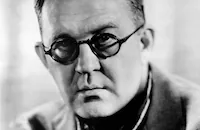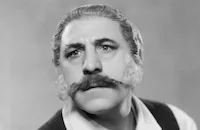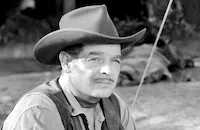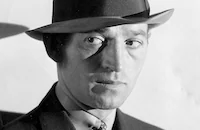Submarine Patrol
Cast & Crew
John Ford
Richard Greene
Nancy Kelly
Preston Foster
George Bancroft
Slim Summerville
Film Details
Technical Specs

Synopsis
In 1918, millionaire playboy Perry Townsend III drives into the Brooklyn Navy Yard to enlist and knocks over the guard at the gate, Joe Duffy. After Rear Admiral Joseph Maitland assigns him to be chief engineer on the submarine chaser 599, Perry helps start a stalled truck driven by attractive Susan Leeds, and as he reaches inside, casually touches her leg. Duffy tries to make a date with Perry's companion Anne, and when Anne sees Perry's interest in Susan, she drives off. Perry gets a ride with Susan and learns that she works on her father's freighter, the Maria Anne , which delivers munitions. While Perry is disappointed in the small wooden subchaser to which he is assigned, he quickly makes friends with the crew, who have developed laxity into a way of life. They go to a saloon, where Perry finds Susan with her father's first mate McAllister, a rude, religious fanatic. Perry has McAllister paged to take a phone call, and then he takes Susan to the Ritz Roof, where they find Duffy dancing with Anne. Afterward, at her cabin, when Susan kisses Perry goodnight, her stern father, Captain Leeds, warns Perry not to see his daughter again and then kicks Perry down the stairs. Admiral Maitland assigns as commander of the subchaser Lieutenant John C. Drake, who has been found guilty of negligence for letting a destroyer run aground on rocks. Maitland allows him four experienced men to make real sailors of the others. Drake immediately orders the crew to clean the ship and Perry to get a regulation uniform. Perry complains to the admiral, who tells him that the Navy has little patience with "pull" and advises him to go back and be a good sailor. Before they go to sea, Perry asks Susan to wait for him and kisses her through the porthole of her father's freighter. Captain Leeds, upset that Perry has given Susan a necklace, throws Perry down despite his protestations that he loves Susan. The subchaser's assignment is to escort the convoy, including Leeds's freighter, to Italy. When a U-boat tries to attack the Maria Anne , the subchaser torpedoes it, but rather than rejoice, the men solemnly salute the enemy men buried at sea. At the port of Brindisi in Italy, Perry gets a message to Susan to meet him at a hotel, where he tells her that he has arranged to marry her in a half hour. Her father and McAllister interrupt them, and after McAllister carries Susan away, Leeds throws Perry down again. After the chaplain shows Leeds a marriage license and proves that Perry really did intend to marry Susan, Leeds goes aboard the subchaser to talk to Perry. Meanwhile, Drake tells his crew that the enemy sub known as "Old Man 26" has just sunk its thirty-first ship. Drake has asked permission to go after it, and all the men volunteer to go on this dangerous mission. When Leeds arrives, Perry knocks him out, and Leeds is stuck on the ship as it pulls out. When he revives, he offers to work in the engine room with Perry. After a surveillance boat makes its way through a mine field and locates the sub ashore, a battle ensues during which Leeds rescues Perry and the sub is sunk. Leeds then gives Perry back the marriage license and shakes his hand. Later, as Susan, her father and the chaplain await Perry for the wedding, a crewman arrives with a note from Perry saying that they are sailing for Malta immediately. The Maria Anne then sails alongside the subchaser, and Perry enlists his fellow crew members to yell to Susan, "Do you love me?" and "Will you wait for me." She has her father and the disheartened McAllister yell back "Yes," and they plan to meet in Gibraltar.

Director

John Ford
Cast

Richard Greene

Nancy Kelly

Preston Foster

George Bancroft

Slim Summerville

John Carradine
Joan Valerie

Henry Armetta

Warren Hymer

Douglas Fowley

J. Farrell Macdonald
Maxie Rosenbloom

Dick Hogan

Ward Bond
Charles Tannen

Robert Lowery

George E. Stone

Elisha Cook Jr.
Jack Pennick
Charles Trowbridge

Moroni Olsen
Harry Strang
Victor Varconi
Russ Clark
Harry Tenbrook
George Bruggeman
Max Wagner
Alan Davis
Murray Alper

Lon Chaney Jr.
Dorothy Christy
Frank Moran
Ferdinand Schumann-heink

Fred Malatesta
Manuel Paris
Duke Green
Ray Cooke
Ernie Alexander

E. E. Clive
Hans Schwimmer
S. East
Crew
Jean Adko
Hilda Anderson
Joe Behm
Harry Brand
Jack Brown
Logan Brown
Clarence Collins
Teodoro Cottrau
Mary Crumley
William Darling
Ralph Dietrich
Don Ettlinger
William Faulkner
Sheridan Gibney
E. F. Grossman
Roger Heman
Lefty Hough
Rian James
Sam Kaufman
Andy Kisch
Joseph La Shelle
Arthur Lange
Jack Lescoulie
Thomas Little
Paul Lockwood
Gene Markey
Gene Markey
Cliff Maupin
Harry Maye
Joe Mcdonough
B. F. Mceveety
V. L. Mcfadden
W. E. Meinardus
Arthur Miller
Ray Moore
Earl Nickerel
Lieut. Cmdr. George O. Noville
Ed O'fearna
Hans Peters
David Preston
H. A. Root
Kathryn Scola
Robert Simpson
Wingate Smith
Meta C. Sterne
Karl Tunberg
Gwen Wakeling
E. Clayton Ward
Darrell Ware
Jack Wells
Captain Valentine Wood
Jack Yellen
Darryl F. Zanuck

Film Details
Technical Specs

Quotes
Trivia
Notes
The working titles of this film were The Splinter Fleet, Suicide Fleet and Wooden Anchors. In a September 4, 1936 story outline in the Twentieth Century-Fox Produced Scripts Collection at the UCLA Theater Arts Library, Tyrone Power is suggested for the role of Perry Townsend; this was prior to his first starring role in Lloyd's of London (see below). William Faulkner was employed as a writer for the film from 4 September to November 30, 1936 and contributed a screenplay with Kathryn Scola. An unsigned summary and analysis of his work included in the Produced Scripts Collection notes, "Unlike the characters in Mr. Faulkner's serious works, the characters in this screen play are ordinary puppets. The incidents are either trite, lacking in humor or pointless, the majority of them being totally unrelated to the general story thread. The story as a whole is diffused to a point where whatever intensity it might have is diluted....The hero, Perry, is flat in character, does not develop with the story, fails to earn our sympathy, and displays nothing of courage or intellect to rate a hero role....The dialogue as dialogue is splendid." The Produced Scripts Collection file on this film contains memos to Zanuck from Jason Joy, Aidan Roark, Jerry Hoffman, Bess Meredyth and Ben Markson, which contain suggestions about the script. A memo in the Twentieth Century-Fox Records of the Legal Department Collection, also at UCLA, acknowledges that the screen credits and advertising for the film mistakenly spelled the author's name "Milholland." The legal records also contain correspondence which relates that although the studio purchased a screen story based on the book by Charles Bruce Millholland, the brother of the author, no part of that material was used in the final film.
In a memo to Darryl Zanuck dated March 12, 1937, Sol M. Wurtzel, in charge of the studio's "B" picture productions, stated that because of the cost to build the boat needed, the film should be considered an "A" picture and be given an "A" cast; this, in fact, is what occurred. According to Variety, four subchasers from 1917, which were still in service in the U.S. Navy, were used in the film in location shots filmed at Annapolis. This was the first film in a number of years for Nancy Kelly, who earlier appeared as a child actor and had recently starred in the Broadway production of Susan and God. According to studio publicity, actor Elisha Cook, Jr. lost the top of his left thumb during the shooting of the storm sequence when his thumb caught on a wire as a wall of water hurled down on him. Added dialogue was then written about his bandaged hand.
Reviewers greatly praised this film. Frank S. Nugent, who later wrote screenplays for director John Ford, wrote in his New York Times review, "That is the way adventure stories should be filmed. We have no qualms about calling this the best of its type this year." Motion Picture Herald commented that the climactic battle scene "is among the best of its kind ever filmed." According to a modern source, Ford cited this as one of his favorite films.












